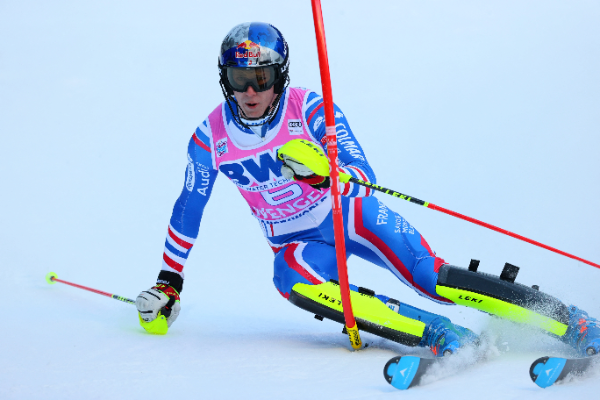Slalom skiing is an exhilarating winter sport that requires skill, agility, and dedication. Whether you’re a beginner looking to improve your basics or an experienced skier aiming to refine your techniques, there’s always room for improvement. This comprehensive guide will provide you with detailed steps and tips to help you get better at slalom skiing.
Understanding the Basics of Slalom Skiing
What is Slalom Skiing?
Slalom skiing is a downhill skiing discipline where skiers navigate through a series of gates, which are closely spaced. The primary objective is to ski between these gates as quickly as possible without missing any. Precision and speed are crucial in slalom skiing.
See Also: How to Bodyboarding with Fins
Essential Gear for Slalom Skiing
- Skis: Slalom skis are shorter and more flexible than other types of skis. They are designed for quick, tight turns.
- Boots: Ensure you have stiff and well-fitted boots for better control.
- Poles: Slalom poles are lightweight and have a protective guard to shield your hands.
- Helmet: Safety is paramount. A good quality helmet is essential.
- Protective Gear: Consider wearing shin guards and padded clothing to protect against gate impacts.
Building a Strong Foundation
Improving Your Balance
Balance is key in slalom skiing. To enhance your balance:
- Practice on One Ski: Try skiing on one ski to improve your balance.
- Use Balance Boards: Off-slope training with balance boards can be very effective.
- Core Exercises: Strengthen your core muscles with exercises like planks and Russian twists.
Strength and Conditioning
A strong body is crucial for slalom skiing. Focus on:
- Leg Strength: Squats, lunges, and leg presses help build powerful legs.
- Endurance: Cardiovascular exercises such as running and cycling improve your stamina.
- Flexibility: Stretching and yoga can increase your flexibility, which is important for agile movements.
Mastering the Techniques
Stance and Positioning
- Athletic Stance: Keep your knees bent, weight slightly forward, and hands in front.
- Hip Position: Keep your hips aligned with your knees and shoulders.
- Arm Position: Hold your poles with your elbows slightly bent and in front of your body.
Carving Turns
- Edge Control: Practice using the edges of your skis to make clean turns.
- Weight Distribution: Distribute your weight evenly across both skis.
- Turn Initiation: Use your knees and ankles to initiate turns.
Gate Handling
- Approach: Plan your approach to each gate, aiming for the optimal line.
- Inside Ski Pressure: Apply pressure on your inside ski to maintain control.
- Cross-Blocking: Use your poles to block the gates as you pass them.
Mental Preparation
Focus and Concentration
- Visualization: Visualize your run before you start.
- Mindfulness: Practice mindfulness to stay present and focused.
Goal Setting
- Set Realistic Goals: Break your goals into manageable steps.
- Track Progress: Keep a journal to track your progress and adjust your goals as needed.
Training and Practice
Structured Training Plans
- Weekly Schedule: Create a weekly training schedule that includes time on the slopes and off-slope exercises.
- Skill Drills: Incorporate specific drills to improve your technique.
- Rest and Recovery: Ensure you have adequate rest to prevent injuries.
Working with a Coach
- Professional Guidance: A coach can provide personalized feedback and guidance.
- Video Analysis: Use video analysis to identify areas for improvement.
Competing in Slalom Skiing
Entering Competitions
- Local Races: Start with local competitions to gain experience.
- National and International Events: As you improve, consider entering larger events.
Race Day Preparation
- Warm-Up: Ensure you have a proper warm-up routine.
- Mental Preparation: Stay calm and focused before your run.
Nutrition and Hydration
Balanced Diet
- Carbohydrates: Provide energy for your skiing sessions.
- Proteins: Help in muscle repair and growth.
- Fats: Essential for long-term energy.
Hydration
- Stay Hydrated: Drink plenty of water before, during, and after skiing.
- Electrolytes: Consider electrolyte drinks to maintain balance.
Safety and Injury Prevention
Safety Measures
- Know Your Limits: Don’t push yourself beyond your skill level.
- Follow Resort Rules: Adhere to all safety guidelines at ski resorts.
Common Injuries and Prevention
- Knee Injuries: Strengthen your knees with specific exercises.
- Ankle Sprains: Ensure your boots fit well and provide adequate support.
- Back Injuries: Maintain a strong core and proper posture.
Staying Motivated
Finding Inspiration
- Watch Professional Skiers: Learn from watching expert skiers.
- Join a Ski Club: Engage with a community of like-minded individuals.
Setting New Challenges
- Try Different Courses: Ski on different courses to challenge yourself.
- Push Your Limits: Gradually increase the difficulty of your training.
Conclusion
Remember that improvement takes time. Celebrate small victories and enjoy the process of becoming a better slalom skier.
By following these tips and dedicating yourself to regular practice, you’ll see significant improvements in your slalom skiing skills. Stay committed, stay safe, and most importantly, have fun on the slopes!

